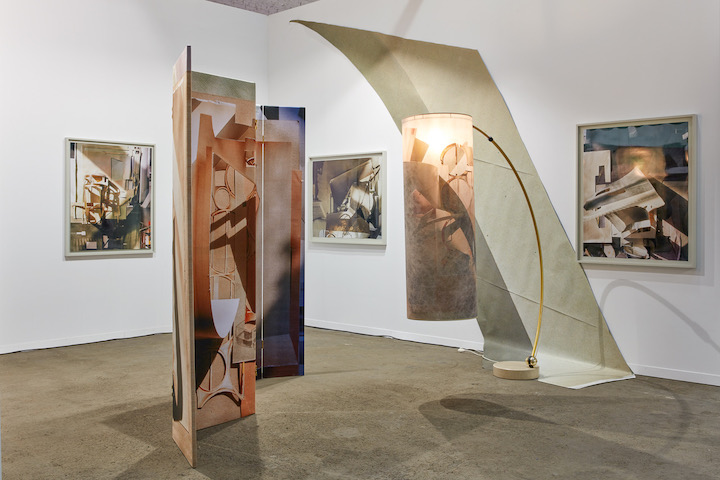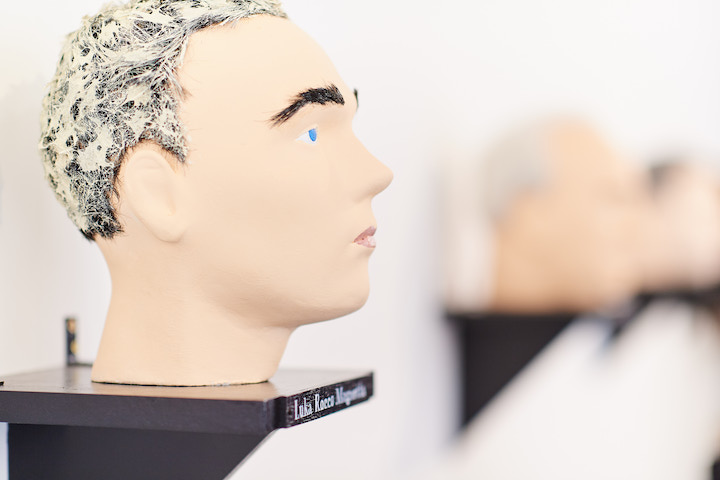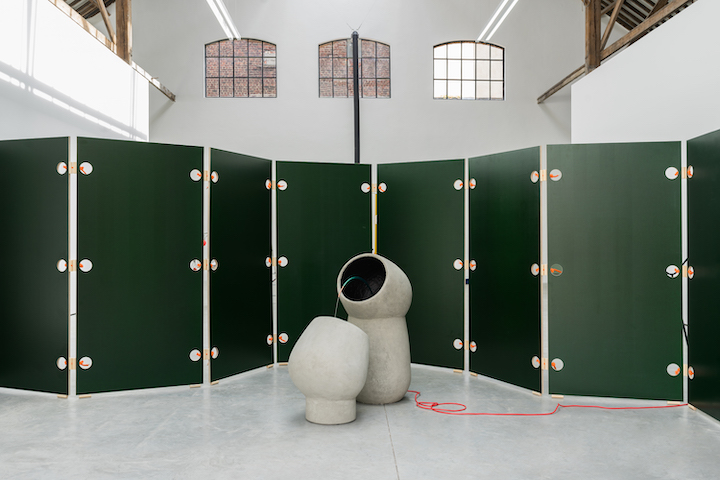This weekend’s 37th Art Brussels art fair this year happens to coincide with Berlin Gallery Weekend, both ahead of the opening of the Venice Biennale. Art Brussels gathers together over 150 international exhibiting galleries, along with a curated video programme and special presentations, so coming up with a comprehensive view what the fair (and the ever-growing Brussels art scene) has to offer might be something of a doomed enterprise. But ArtReview likes a challenge, so here’s its all-too-subjective snap of the bits it likes at the fair, and around Brussels right now…

Anita Witek at l’Etrangère
At London’s l’Etrangère gallery booth (in the ‘Discovery’ section of young and emerging galleries), Austrian artist Anita Witek’s photographs are mesmerising reflections on the nature of images. Photographs of complicated assemblages of what look like cut-out card and paper, Witek’s materials are the left-overs of photographs once all the significant subject-matter has been chopped out of them. Pale spaces of wall, corners of ceilings, angles of window frames, shuffled together. There’s always a lot of idle talk in art fairs about artists who work ‘between figuration and abstraction’; Witek’s images are more about the awareness of how images disintegrate only to produce different images, while also recording a process of shaping and making something essentially sculptural out of such fragments, only to capture it, once again, in the uncertain posterity of a photograph.

Goldin+Senneby at NOME
That kind of circular, reflexive intelligence takes on a more political and social edge in a characteristically mischievous project by Goldin+Senneby, at the stand of Berlin’s NOME, The Plot (Utopia Bloemen) (2018/19). The Plot refers to a demarcated area on the floor of the booth, which is also the boundary of a plot of land in Genk, the old coal mining area of Belgium, which a collector would acquire (there’s no option not to) as part of buying the work in the gallery. That work is a custom-built wooden chest which contains coal powder and Vaseline, and a set of stencils with which to produce various patterns reminiscent of carboniferous-era fossils found in the said region. Art collectors come to art fairs to buy ‘portable’ art objects – here they get a plot of post-industrial land too, whether they like it or not. A poem by Turkish-born Belgian poet Mustafa Kör is inscribed in the box’s lid – about his father’s uprooted life as an immigrant – completes the work’s winding connections between human life, capital, art and pre-human history. Whether collectors will appreciate the wry humour of the work in committing to buy it is another matter.

As at most art fairs there’s a fair bit of colourful, feelgood works on show at Art Brussels. But the dark and the disturbing is here in strength too, none more so than Irmgard Speck, an installation of crude, dummy-like heads mounted on shelves, by Belgian duo Jos de Gruyter and Harald Thys. The two artists are representing Belgium at the Venice Biennale next month, and Irmgard Speck showcases their bleak, though not uncomic nihilism. Each head is a likeness of people alive or dead, famous or unknown, murderers, victims, local characters, politicians and dictators. An accompanying directory lists their lives and achievements without offering judgement or preference. A strange, cold, but weirdly sentimental monument to human society, seen as a never-ending river of battered desires and dashed ambitions.

Paul Neagu at Ivan Gallery
Part of the ‘Rediscoveries’ grouping of galleries at the fair (presentations of work by artists who haven’t had the visibility they deserve) is the elegant showing of work by Romanian artist Paul Neagu, who moved to London in1969 and lived there until his death in 2004. Painter and performance artist, Neagu developed an iconography of the human body which presents it as the intersection of conflicting desires and social constraints, often through the motif of the body as composed of geometric cells. In London, Neagu taught artists such as Anthony Gormley and Anish Kapoor, and it’s tempting to wonder how Neagu’s metaphysical thinking about matter and the human body might have left traces in their work.

Koenraad Dedobbeleer at Clearing Brussels, through 31 May
Belgian artists seem to excel in a kind of droll cynicism, revelling in how art can work with a sense of its own disappointed ambitions. So away from the fair, a good example of this is Koenraad Dedobbeleer’s cartoonlike furniture-cum-sculpture, in which colourfully painted, chunky, mass-produced elements and finishes come together in confidently counterintuitive ways. Mundane things are given exaggerated, celebratory status – a hanging tangle of lantern lights forms a kind of curtain, a mint-coloured tubular swing gate acts as a pointless barrier to a gallery sideroom, its frame topped off by a cheerful uplighter. Dedobbelaer’s humour has something to do with refusing to be drawn into commitments about what artworks should do or not do, allowing them to drift in and out of history and the present, function and uselessness.

Anicka Yi, Gladstone Gallery, through 15 June
Myth-making about the near future seems to be something of a theme in current art, and Anicka Yi’s sculptures and objects at Gladstone cut to the quick of our anxieties over technology, ecology and human identity. In the downstairs space, a room full of greenish, spherical hanging lampshades appear to trap a moth or butterfly, its shadowy presence clattering against the inside of the translucent shade. Peer inside, that these are artificial simulations, a mechanical arm, microprocessor and servomotor built into the insides. Upstairs, picture frame-sized aquaria contain tiny live water insects flitting among algae itself growing on synthetic armatures shaped like jelly-fish. Other bas-relief wall-sculptures present glossy fragments of human and natural artefacts, suggesting a fusion of the biological and technological. Unnerving and compelling, Yi’s objects suggest a Blade Runner future, giving tangible shape to the possible futures facing humans and ecosystems.
Online exclusive, 27 April 2019
